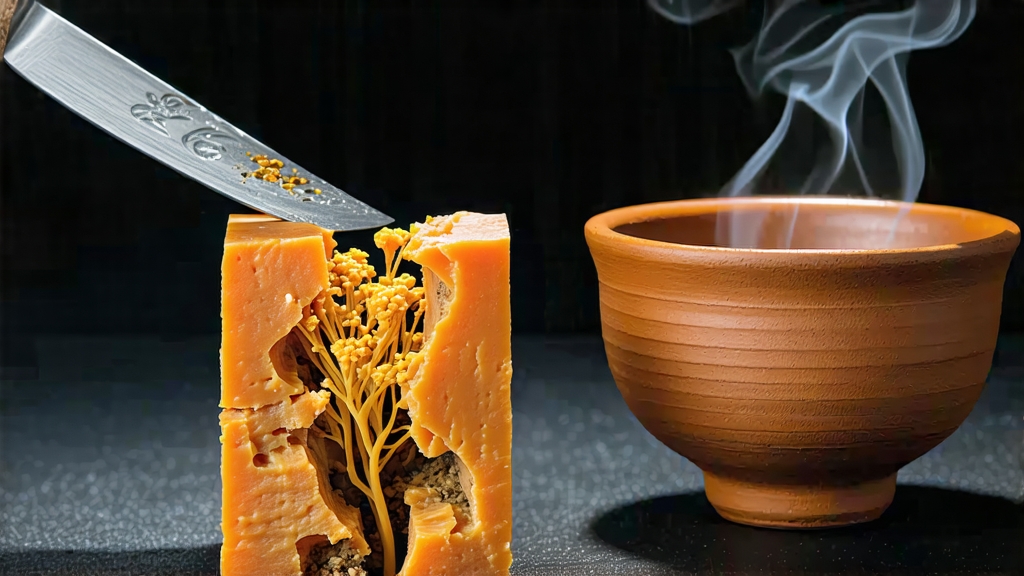
If green tea is the fresh-faced youth of Chinese tea culture, then Fu brick tea—dark, rugged, and quietly humming with living spores—is the wise elder whose stories are written in every wrinkle of its compressed leaf. Nestled within the broader family of Chinese dark teas (heicha), Fu zhuan cha, literally “Fu brick tea,” is the only tea deliberately inoculated with a beneficial mold that blooms into tiny golden flecks nicknamed “golden flowers” (jin hua). These flowers are not decorative; they are the biochemical engine that transfigures rough leaf into a mellow, medicinal liquor prized along the ancient Silk Road and now sought after by global tea connoisseurs.
Historical caravans departing Xi’an for the Tibetan Plateau or the Mongolian steppe needed a tea that would survive months of yak-back transport, sub-zero nights, and scorching desert days. In the early 1360s, tea makers in Jingyang county, Shaanxi, discovered that if they steamed loose Hunan dark tea, packed it into thirty-kilogram fir-wood molds, and allowed a secondary fermentation inside humid storerooms, the tea not only resisted moldy spoilage but actually improved, developing a sweet, fungal aroma reminiscent of wet chestnuts and dried apricots. The imperial court soon designated this “official tribute for frontier trade,” and thus Fu brick became the currency that bought warhorses, wool, and jade, lubricating half a millennium of trans-Asian commerce.
Although the name “Fu” once referred to the government-run “Fu Tea Bureau,” today it denotes a specific processing style rather than geography. Ninety percent of authentic Fu bricks still originate in three counties of Shaanxi—Jingyang, Sanyuan, and Jingyang—using autumn-harvested large-leaf tea trucked in from Hunan’s Anhua mountains. The leaf must be tough enough to withstand repeated steamings yet rich in polysaccharides that Eurotium cristatum, the golden-flower fungus, can feast upon. Tea masters grade the incoming maocha into three categories—teji (special grade), yiji (first grade), and erji (second grade)—based on stalk content, leaf size, and moisture. Only the top two grades qualify for the “flowering” step, while the remainder becomes ordinary dark brick without the coveted bloom.
Crafting a Fu brick is a choreography of moisture, heat, pressure, and time. First, the leaf is rehydrated to 28 % moisture and steamed for ninety seconds to soften cellulose. While still hot, it is wheeled into a dark, cedar-lined room where workers wearing cotton gloves tamp the tea into brick-shaped iron frames lined with hemp cloth. A hydraulic press exerts five tons of pressure for precisely four minutes, compacting the leaf into a dense block that will later be sliced into one-kilogram rectangles. The bricks are then stacked like cordwood in “fermentation houses” kept at 28 °C and 75 % relative humidity for twelve to fifteen days. During this period Eurotium cristatum spores germinate, sending hyphae through the tea matrix and secreting enzymes that oxidize catechins, hydrolyze starch, and liberate amino acids. The fungus eventually sporulates, painting the cut surface of the brick with a constellation of golden dots—each one a microscopic puffball containing billions of spores. When the flowers reach a density of 50,000 to 100,000 colonies per gram, the bricks are slowly dried at 45 °C for three days to arrest microbial activity while preserving aromatic volatiles.
The finished brick is a paradox: visually rustic, yet biochemically refined. Snap one in half and you will hear a crisp crack, like breaking a chocolate bar. The cross-section reveals alternating veins of dark mahogany leaf and ochre mycelium, releasing an aroma that mingles damp earth, sweet hay, and a whisper of sandalwood. Laboratory analyses show that the golden flowers convert bitter catechins into gallic acid and theaflavin derivatives, reducing astringency while creating a silky, cooling mouthfeel. They also synthesize unique chromones and polyketides that display hypolipidemic and antimicrobial activity—findings that have propelled Fu brick into functional-food circles across Europe and North America.
To brew Fu brick